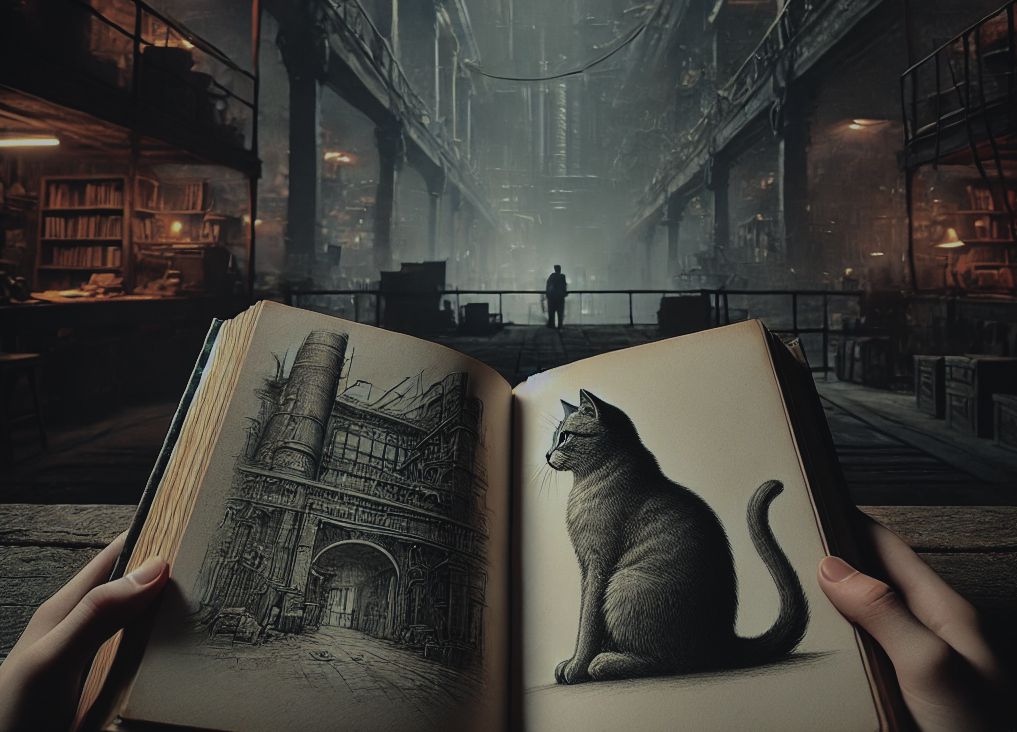VISUAL PROMPT

A character from a dystopian future where all non-human animals are extinct reads an ancient text about something called a 'cat'...
Legacy of the Divine Cat
In the corrugated shadows of a ruined metropolis where nature’s voice had long been silenced, Julian wandered in search of remnants from a world now vanished. In this dystopian future, non-human animals had been erased from the annals of life—a casualty of mankind’s relentless ambition and technological conquest. Yet, amid the desolation, faint whispers of a bygone era still clung to the crumbling edifices of the old world.
On one such grey morning, as he explored the husks of a long-forgotten municipal library, Julian’s eyes caught sight of something extraordinary: a delicate, timeworn parchment, hidden within a mouldering chest. Its brittle fibres and faded ink immediately transported him into a realm of mystery. The manuscript, penned in a script that harked back to ancient civilisation, bore a title that sent a shiver down his spine: *The Legacy of the Divine Cat*.
As Julian began to decipher the archaic verses, a fantastical narrative unfolded before him. The text described a creature known only as the “cat”—a being so enigmatic and graceful that its mere presence seemed an act of divinity. According to the ancient words, in a time when Egypt bloomed with splendour and mystery, these creatures were more than mere animals. They were revered by Pharaohs who believed that the cat possessed an otherworldly connection to the gods. In sacred temples and beneath the gaze of colossal pyramids, cats were honoured as emblems of fertility, protection, and the eternal magic of the desert.
The manuscript painted a vivid tapestry of sensory wonder. It spoke of the silken feel of a cat’s coat, soft as the finest linen yet resilient under the relentless desert sun. It described eyes aglow with a golden intensity—a luminescence that rivalled the brilliance of the midday sun over the Nile. There were passages alluding to the enchanting murmur of a cat’s purr, which, like whispered secrets in a quiet temple, resonated with the mystical chord of cosmic harmony. The text even recounted how Pharaohs would cradle these creatures as if safeguarding a connection to the divine, their royal hearts softened in the presence of unparalleled elegance.
As Julian read on, he could almost taste the ambrosial air of ancient Egypt—a heady mixture of sun-dried earth, frankincense, and the salty tang of the river Nile. The words evoked the image of a grand pyramid, its stone façade bathed in the glow of a dying day, where richly adorned chambers echoed with the silent footsteps of cats once revered as sovereigns of a sacred realm. In that moment, the manuscript transformed from a brittle relic into a portal that bridged an unimaginable gulf between past and present.
Overwhelmed by a mix of wonder and profound melancholy, Julian closed the manuscript with reverence. The discovery of this text, with its tales of regal felines and imperial devotion, stirred something long-dormant within him—a yearning for the wild, irreplaceable beauty of creatures that had once roamed freely. In a world where every living creature had been sacrificed at the altar of progress, this ancient narrative ignited a spark of hope and defiance. It was a poignant reminder that beauty, grace, and the enigmatic allure of life had not been eradicated entirely; they still lived on in memory and myth.
Clutching the fragile parchment to his chest, Julian stepped out into the stark light of an unforgiving future. As the wind whispered through broken streets and scattered remnants of humanity’s lost dreams, the legacy of the cat, as immortalised by Egyptian lore, began to echo in his heart. There, amid the decay and desolation, lay the promise of a time when nature might be restored—and with it, the delicate purr of a creature both divine and free.
